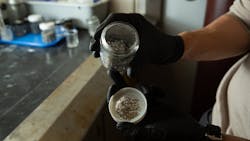Green or Greenwash? Two Perspectives on Aluminum-Derived Hydrogen Fuels
What you’ll learn:
- Researchers at MIT and other institutions are investigating a simple process that can economically produce hydrogen gas from scrap aluminum and seawater at a commercial scale.
- The technology’s critics say that the process removes easily recyclable materials from the global supply chain and forces the industry to refine more aluminum from raw ore using nearly 20X the energy.
- Readers can explore the pros and cons and find resources to learn more about both sides of this issue.
A technique for using scrap aluminum and seawater to generate “green” hydrogen for use as an automotive fuel is creating equal measures of hope and controversy within the scientific community.
MIT is one of several organizations pursuing research on turning scrap aluminum into fuel. It’s a process that the researchers believe can overcome the economic and technical challenges that have plagued the adoption of hydrogen as an automotive fuel for over two decades.
Other researchers are skeptical about how “green” the process actually is, since it extracts embedded energy from refined aluminum by, in effect, “burning” the valuable metal and rendering it effectively unrecoverable.
This development is one example of several so-called Green H2 production technologies that promise to be an alternative to conventional processes. Others include electrolysis of water and steam-methane reformation of natural gas.
Electrolysis is a relatively clean process, but scaling it to industry-scale has been challenging. It also has low conversion efficiencies, typically 60% to 75%, and that’s before the additional energy required to compress the gas to 2,500-3,500 pi for storage is factored in.
These issues are some of the reasons that steam reformation still produces roughly 95% of today’s H2 supply. It burns 25% to 35% of the fuel in the process, while leaving tons of undesired byproducts (CO and CO2) to be disposed of somehow.
MIT’s Low-Carbon Aluminum-Based “Green” Hydrogen
In contrast, MIT’s news release cites a recent study, published in Cell Reports Sustainability,1 that describes its technology as “a low-carbon, cost-effective process based on the aluminum-water reaction (AWR), which uses recycled aluminum, waste heat, and alloy recovery to produce hydrogen with just 1.45 kgCO2 (equivalent) per kg of hydrogen.”
In addition to being cost-competitive with other commercial green hydrogen technologies (around $9/kg), the study claims that the commercial value of the byproducts it produces (such as boehmite ) will make the process a commercial success.
These optimistic claims are being challenged by other researchers who point out that the process simply extracts the 13 to 16 kWh worth of electricity, which had originally been used to refine it from alumina ore in the first place—much of it is still produced by coal- and gas-fired powerplants. And this doesn’t even count the 400 kg worth of carbon anodes that the Hall-Héroult electrolytic process consumes per metric ton of aluminum it produces.
While it’s far better to use scrap aluminum to produce hydrogen fuel than consign it to a landfill, recycling it into virgin stock requires roughly 5% of the energy required to refine it from raw bauxite. It’s no wonder then that scrap aluminum’s market value hovers in the range of $800-$1,100 per ton.
Critics of aluminum-derived H2 point out that a whole-lifecycle analysis of the process brings into question many of the process’ claimed economic and environmental benefits.
Meanwhile, as this story goes to press, your intrepid editor has uncovered news from Peregrine Hydrogen Inc. about its novel hydrolysis technology that requires 50% less energy and produces valuable industrial byproducts. It may shift the H2 debate yet once again. Stay tuned for more details soon…
With the merits of AL-2-H2 still undecided, we invite you to read further and draw your own conclusions. Here are a few good places to start:
- Study shows making hydrogen with soda cans and seawater is scalable and sustainable
- Why Would You Make Hydrogen From Aluminum?
- Peregrine Hydrogen ($8 million to develop SO2 depolarized electrolyzer to produce green fertilizers)
Reference
1. Aly Kombargi, et al., “Life-cycle assessment and cost analysis of hydrogen production via aluminum-seawater reactions,” Cell Reports Sustainability, 100407.
Next in This Edition of PowerBites
More PowerBites
About the Author
Lee Goldberg
Contributing Editor
Lee Goldberg is a self-identified “Recovering Engineer,” Maker/Hacker, Green-Tech Maven, Aviator, Gadfly, and Geek Dad. He spent the first 18 years of his career helping design microprocessors, embedded systems, renewable energy applications, and the occasional interplanetary spacecraft. After trading his ‘scope and soldering iron for a keyboard and a second career as a tech journalist, he’s spent the next two decades at several print and online engineering publications.
Lee’s current focus is power electronics, especially the technologies involved with energy efficiency, energy management, and renewable energy. This dovetails with his coverage of sustainable technologies and various environmental and social issues within the engineering community that he began in 1996. Lee also covers 3D printers, open-source hardware, and other Maker/Hacker technologies.
Lee holds a BSEE in Electrical Engineering from Thomas Edison College, and participated in a colloquium on technology, society, and the environment at Goddard College’s Institute for Social Ecology. His book, “Green Electronics/Green Bottom Line - A Commonsense Guide To Environmentally Responsible Engineering and Management,” was published by Newnes Press.
Lee, his wife Catherine, and his daughter Anwyn currently reside in the outskirts of Princeton N.J., where they masquerade as a typical suburban family.
Lee also writes the regular PowerBites series.






